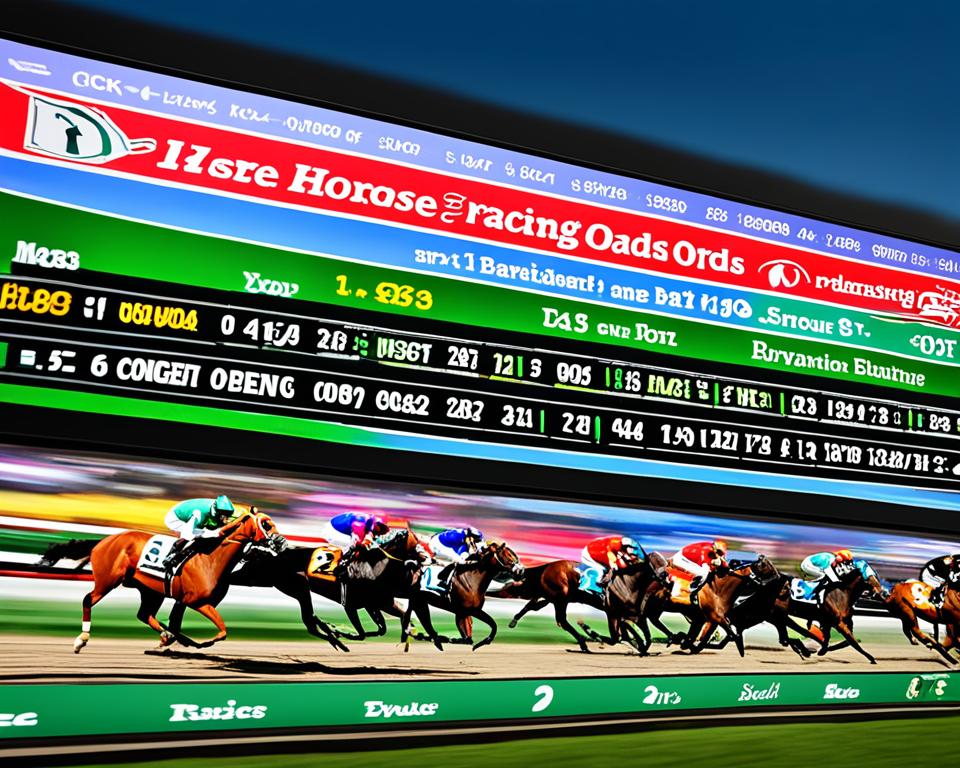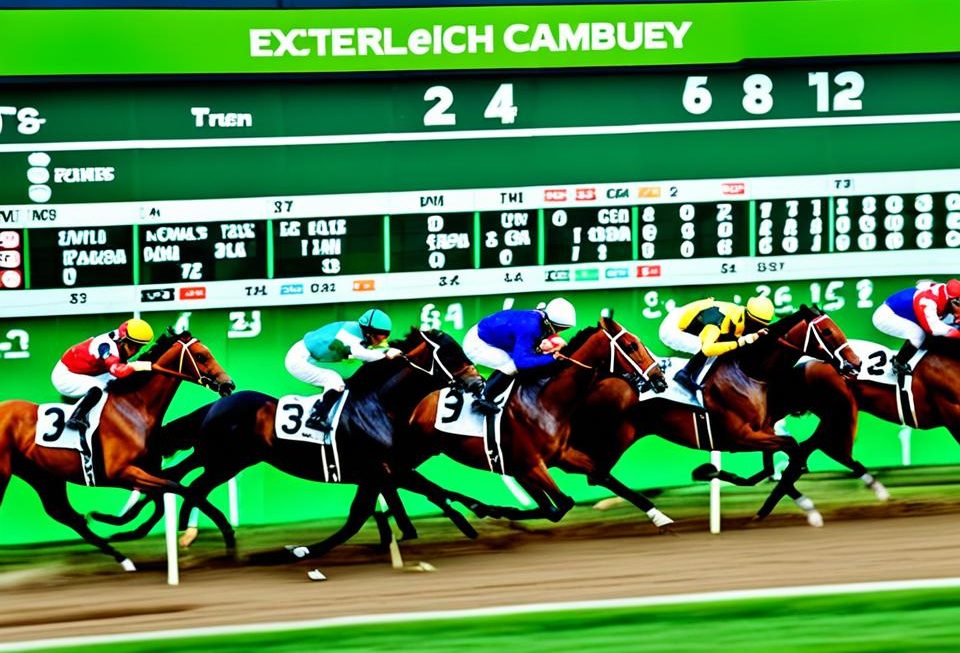In the captivating world of horse racing, understanding the intricacies of odds is paramount for bettors seeking to make informed wagers and maximize their potential returns. This comprehensive guide will delve into the mechanics of how horse racing odds work, exploring the pari-mutuel wagering system, the various odds formats and representations, the role of odds compilers, and the crucial concepts of favorites, longshots, and probability. By the end of this article, readers will possess a firm grasp of the fundamental principles and practical applications of horse racing odds, empowering them to navigate the betting landscape with confidence and make more profitable decisions.
Read interesting things at : vetocellacvgummies
Key Takeaways
- The pari-mutuel wagering system is the foundation of horse racing betting, where bets are pooled and payouts are determined by the total amount wagered and the number of winning tickets.
- Horse racing odds can be represented in various formats, including American odds, decimal odds, and fractional odds, and it’s important to understand how to convert between these formats.
- Odds compilers play a crucial role in setting and adjusting horse racing odds, analyzing factors such as horse and jockey performance, track conditions, and market trends.
- Odds fluctuations and real-time updates are common in horse racing, as odds can change significantly leading up to and during a race due to late-breaking news, changing betting patterns, and continuous adjustments by odds compilers.
- Understanding the relationship between odds and probability is essential for making informed betting decisions, as it allows bettors to evaluate the true likelihood of a horse’s success.
Introduction to Horse Racing Odds
Understanding horse betting odds is crucial for anyone looking to engage in successful horse racing wagering. These odds play a vital role in determining potential payouts and the probability of a horse winning a race, making them a fundamental aspect of the pari-mutuel wagering system that governs most horse racing betting. In this section, we’ll explore the importance of understanding horse racing odds and delve into the various types of bets available in the sport.
Importance of Understanding Odds
Odds are the foundation of horse racing betting, as they provide invaluable information about the likelihood of a horse winning a particular race. By comprehending how horse racing odds work, bettors can make more informed decisions, assess the potential risks and rewards of their wagers, and develop effective betting strategies. Mastering the intricacies of horse racing odds allows bettors to better navigate the complex world of pari-mutuel wagering and increase their chances of successful and profitable bets.
Types of Horse Racing Bets
In horse racing, there are numerous bet types available, each with its own unique characteristics and payoff potential. Some of the most common bets include:
- Win: A bet on a horse to finish in first place.
- Place: A bet on a horse to finish in first or second place.
- Show: A bet on a horse to finish in first, second, or third place.
- Exacta: A bet on the horses finishing in first and second place in the exact order.
- Trifecta: A bet on the horses finishing in first, second, and third place in the exact order.
The horse racing odds associated with each bet type directly impact the potential payouts, making them a crucial factor in the decision-making process. Understanding the relationship between odds and the various bet types is essential for developing successful betting strategies and maximizing returns.
Pari-Mutuel Wagering System
At the core of horse racing betting lies the pari-mutuel wagering system, a unique approach that sets it apart from other sports betting formats. This system, which originated in France in the 19th century, pools all bets placed on a race and then distributes the winnings proportionally among the successful bettors. The pari-mutuel system is the foundation upon which the horse racing odds formats and calculating horse racing payouts are built.
How Pari-Mutuel Betting Works
In the pari-mutuel wagering system, bettors place their wagers on a specific horse or combination of horses to win, place, show, or achieve a more complex outcome, such as an exacta or trifecta. All the money wagered on a particular race is pooled together, and the racetrack takes a percentage as the “house cut” or “takeout.” The remaining funds are then distributed among the winning bettors, with the payouts being determined by the total amount wagered and the number of winning tickets.
The pari-mutuel wagering system allows bettors to directly compete against one another, rather than against the racetrack or a bookmaker. This system creates a dynamic and fluid betting environment, where horse racing odds can fluctuate in real-time as more bets are placed, ultimately shaping the final payouts for successful wagers.
By understanding the mechanics of the pari-mutuel system, horse racing bettors can better grasp the factors that influence calculating horse racing payouts and make more informed decisions when placing their wagers.
How Horse Racing Odds Work
Understanding how horse racing odds work is crucial for making informed betting decisions. Horse racing odds are typically represented in three main formats: American odds, decimal odds, and fractional odds. Mastering the conversion between these formats can help bettors better comprehend the potential payouts and probabilities associated with their wagers.
Odds Formats and Representations
American odds, also known as moneyline odds, are displayed as positive or negative numbers. Positive odds indicate the amount a bettor would win for every $100 wagered, while negative odds represent the amount a bettor must wager to win $100. Decimal odds, on the other hand, show the total payout, including the original stake, for every $1 wagered. Fractional odds are expressed as a ratio, such as 5/2 or 3/1, and represent the potential profit in relation to the stake.
Calculating Payouts and Winnings
The key to understanding how horse racing odds work is being able to calculate potential payouts and winnings based on the odds and the amount wagered. For American odds, the payout is calculated by dividing the stake by the absolute value of the odds and multiplying by 100 for positive odds, or dividing the stake by the odds and adding the stake for negative odds. Decimal odds simply require multiplying the stake by the decimal value, while fractional odds involve dividing the stake by the denominator and multiplying by the numerator to determine the potential payout.
By understanding the various horse racing odds formats and mastering the calculations, bettors can confidently assess the potential risks and rewards associated with their wagers, ultimately enhancing their understanding of how horse racing odds work and improving their overall betting strategy.
Horse Racing Odds Compilers
At the heart of the intricate world of horse racing odds are the dedicated professionals known as odds compilers. These individuals play a crucial role in setting and adjusting the odds, reflecting the ever-changing dynamics of the sport. Horse racing odds compilers are responsible for analyzing a vast array of factors to determine the probability of each horse’s success, enabling bettors to make informed decisions.
Role of Odds Compilers
Odds compilers are the driving force behind the odds-setting process. Their primary responsibilities involve closely monitoring horse and jockey performance, analyzing historical data, and assessing the impact of various factors on the likelihood of a horse winning a particular race. From evaluating the health and form of the contenders to considering track conditions and weather forecasts, odds compilers meticulously gather and synthesize information to establish the most accurate odds possible.
Factors Influencing Odds Calculations
The process of calculating horse racing odds is a complex and multifaceted endeavor. Odds compilers must take into account a diverse range of variables when formulating their odds estimations. These factors can include, but are not limited to:
- Horse performance history and recent form
- Jockey’s experience, skill, and track record
- Track conditions and surface characteristics
- Weather forecasts and their potential impact on the race
- Betting patterns and market trends
- Injuries, withdrawals, and late-breaking news
By carefully considering these factors influencing odds calculations, odds compilers are able to provide bettors with the most accurate and up-to-date odds, reflecting the true probabilities of each horse’s chances of winning.
Odds Fluctuations and Real-Time Updates
In the dynamic world of horse racing, horse racing odds fluctuations are a constant occurrence, with odds shifting rapidly leading up to and during a race. These fluctuations can be attributed to a variety of factors, including late-breaking news, changing betting patterns, and the continuous adjustments made by odds compilers.
As bettors take their positions, the odds on various horses can experience significant changes based on the inflow of wagers. Factors such as jockey or trainer changes, injury updates, or even weather conditions can influence the betting public’s perception of a horse’s chances, leading to rapid adjustments in the horse racing odds fluctuations.
Odds compilers play a crucial role in monitoring and updating the odds in real-time, ensuring that the betting markets accurately reflect the latest information and betting trends. Their keen analysis of horse and jockey performance, track conditions, and other critical factors allows them to make timely adjustments to the horse racing odds fluctuations, providing bettors with the most current and reliable odds.
Real-time updates on horse racing odds fluctuations have become increasingly important for bettors, enabling them to track the dynamic nature of the odds and make informed decisions. By closely following these changes, bettors can identify opportunities, adjust their strategies, and capitalize on the latest insights to enhance their chances of successful wagers.

Understanding Odds Probability
In the captivating world of horse racing, the concept of odds probability is a fundamental aspect that bettors must comprehend. The relationship between odds and probability is a crucial piece of the puzzle when it comes to making informed wagering decisions.
Relationship Between Odds and Probability
The odds offered on a horse reflect the implied probability of that horse winning the race. The lower the odds, the higher the probability of the horse’s success, and vice versa. By understanding this relationship, bettors can gain valuable insights into the likelihood of a particular outcome, empowering them to make more strategic choices.
Calculating Probability from Odds
To calculate the probability of a horse winning from the given odds, bettors can use the following formula:
| Odds Format | Probability Calculation |
|---|---|
| American Odds | Probability = 100 / (Odds + 100) |
| Decimal Odds | Probability = 1 / Odds |
| Fractional Odds | Probability = Numerator / (Numerator + Denominator) |
By applying these calculations, bettors can determine the true probability of a horse’s success and compare it to the implied probability reflected in the odds. This understanding enables them to identify potential value bets and make more informed decisions when placing their wagers.
Favorites and Longshots in Horse Racing
In the thrilling world of horse racing, horses are often classified as either favorites or longshots based on their odds. Identifying and understanding the dynamics between these two categories is crucial for bettors seeking to maximize their chances of successful wagers.
Identifying Favorites and Longshots
Favorites are the horses with the lowest odds, indicating a higher perceived probability of winning. These horses are typically the most heavily backed by bettors and are often the focus of attention leading up to a race. Longshots, on the other hand, are the horses with significantly higher odds, suggesting a lower probability of victory but the potential for larger payouts.
Betting Strategies for Favorites and Longshots
When it comes to betting on horse racing, each category of horses presents its own set of opportunities and challenges. Backing favorites can provide a more reliable, consistent return, but the payout odds may be lower. Conversely, wagering on longshots can yield substantial rewards, but the risk of losing is also higher. Successful bettors often employ a combination of strategies, incorporating both favorite and longshot bets to diversify their portfolio and manage their overall risk exposure.
Understanding the nuances of horse racing odds favorites and longshots, as well as the betting strategies for favorites and longshots, is essential for making informed decisions and maximizing the potential returns from your horse racing wagers.
Horse Betting Odds Explained
Understanding the different odds formats used in horse racing betting is crucial for making informed wagers. This section will provide a comprehensive overview of the common odds formats and explain how to convert between them, empowering bettors to make accurate comparisons and calculations.
Common Odds Formats
In the world of horse racing odds, there are three main formats that bettors encounter: American odds, decimal odds, and fractional odds. Each format presents odds in a distinct manner, and it’s essential for bettors to be familiar with all three to navigate the horse racing odds landscape effectively.
Converting Between Odds Formats
Navigating the different horse racing odds formats can be challenging, but with the right tools and understanding, bettors can seamlessly convert between them. This section will provide step-by-step guidance on how to convert American odds to decimal odds, fractional odds to American odds, and vice versa, ensuring that bettors can make informed comparisons and calculations across various odds formats.
| Odds Format | Explanation | Example |
|---|---|---|
| American Odds | Represent the potential payout relative to a $100 bet. Positive odds indicate the amount you can win for a $100 bet, while negative odds indicate the amount you need to bet to win $100. | +200 (bet $100 to win $200) or -150 (bet $150 to win $100) |
| Decimal Odds | Represent the total payout, including the original stake, for a $1 bet. Decimal odds are calculated by dividing the total potential payout by the stake. | 3.00 (bet $1 to win $3) or 1.67 (bet $1 to win $1.67) |
| Fractional Odds | Represent the ratio of the profit to the stake. The first number in the fraction represents the profit, while the second number represents the stake. | 5/2 (bet $2 to win $5) or 3/1 (bet $1 to win $3) |
Pari-Mutuel Wagering Techniques
The pari-mutuel wagering system in horse racing offers a unique set of opportunities for bettors to employ various strategies and techniques to maximize their potential returns. This section will explore some of the key approaches that savvy bettors can utilize when engaging in pari-mutuel betting.
Betting Strategies for Pari-Mutuel Wagering
One popular strategy in the pari-mutuel wagering system is hedging. This involves making multiple bets on the same race to lock in a guaranteed profit, regardless of the outcome. Bettors can, for instance, place a win bet on a favorite and an exacta bet involving the favorite and a longshot, ensuring a return on their investment.
Another effective technique is value betting, where bettors identify horses with odds that underestimate their true probability of winning. By carefully analyzing the odds, form, and other factors, bettors can uncover value opportunities and place bets that offer the potential for higher payouts relative to the risk.
Additionally, the use of exotic wagers, such as exactas and trifectas, can be a powerful strategy in the pari-mutuel wagering system. These bets require correctly predicting the top finishers in a specific order, often resulting in higher payouts. Skilled bettors can leverage their knowledge of horse racing and odds to construct well-researched exotic wagers that offer the chance to maximize their potential returns.
By employing these and other innovative betting strategies for pari-mutuel wagering, bettors can navigate the complexities of the horse racing betting landscape with greater confidence and potentially enhance their overall profitability.
Odds Compilers and Handicapping
Understanding the role of horse racing odds compilers and the factors they consider when setting and adjusting the odds can provide valuable insights for bettors. These odds compilers are responsible for analyzing a multitude of variables that influence the likelihood of a horse’s success, allowing them to establish the most accurate odds possible.
Factors Considered by Odds Compilers
The factors influencing odds calculations that odds compilers carefully analyze include horse and jockey performance, track conditions, weather, race history, and market trends. They meticulously evaluate each horse’s recent form, fitness, and past success, as well as the abilities and experience of the jockeys. Additionally, they closely monitor factors such as track surface, moisture levels, and any changes that could impact a horse’s chances of winning.
By considering these factors influencing odds calculations, odds compilers aim to create a comprehensive picture of the race’s dynamics and the relative strengths of the participating horses. This information is then used to set and continuously update the odds, ensuring they accurately reflect the true probabilities of each horse’s potential outcome.
Using Handicapping for Betting Decisions
Savvy bettors can leverage the insights gained from understanding how horse racing odds compilers operate and the factors they analyze. By employing handicapping techniques, bettors can supplement their knowledge of the odds and make more informed betting decisions.
Handicapping involves in-depth research and analysis of the various factors that influence a horse’s performance, such as its past race results, jockey and trainer statistics, track preferences, and current form. By combining this information with an understanding of how odds compilers calculate the odds, bettors can identify potential value bets and make more strategic wagering choices.

Ultimately, by understanding the factors influencing odds calculations and applying handicapping principles, bettors can gain a competitive edge and make more informed decisions when placing their horse racing wagers.
Odds Movements and Market Efficiency
The horse racing betting market is a dynamic and ever-evolving landscape, with odds constantly fluctuating in response to a variety of factors. Understanding the factors that influence these horse racing odds fluctuations is crucial for bettors looking to make informed decisions and potentially capitalize on market inefficiencies.
Factors Influencing Odds Movements
The factors influencing odds movements in horse racing are multifaceted. Late-breaking news, such as jockey or trainer changes, scratches, or updated injury reports, can significantly impact the odds as bettors react to this new information. Additionally, shifting betting patterns and the continuous adjustments made by odds compilers play a crucial role in shaping the odds throughout the day and even during a race.
Monitoring these real-time odds movements and the underlying factors driving them can provide valuable insights for bettors. By staying informed and responsive to these changes, they can potentially identify opportunities to capitalize on mispriced horses or make more informed betting decisions.
Efficient Market Hypothesis in Horse Racing
The efficient market hypothesis is a concept that has been extensively debated in the context of horse racing betting. This hypothesis suggests that the horse racing market is efficient, meaning that all available information is already reflected in the current odds, leaving little opportunity for bettors to consistently outperform the market.
However, some experts argue that the horse racing market may not always be entirely efficient, particularly in the short-term. Factors such as information asymmetry, behavioral biases, and the impact of large bettors can create temporary inefficiencies that savvy bettors may be able to exploit through careful analysis and strategic betting.
By understanding the dynamics of the horse racing betting market and the factors that influence odds movements, bettors can develop a more nuanced perspective on the efficient market hypothesis and explore ways to potentially identify and capitalize on market inefficiencies.
Probability and Value Betting
Understanding the relationship between probability and value betting is crucial in the world of horse racing. By calculating the true probability of a horse’s success based on the odds, savvy bettors can identify value bets where the true probability exceeds the implied probability reflected in the odds.
Calculating Value Bets
To determine the true probability of a horse’s success, bettors need to analyze the odds being offered. By converting the odds into a probability percentage, they can compare the true probability to the implied probability. When the true probability is higher than the implied probability, a value bet can be identified, offering the potential for greater returns.
For example, if a horse is offered at 5-1 odds, the implied probability would be 16.67% (1 / (5 + 1)). However, if the bettor’s analysis suggests the horse’s true probability of winning is 20%, then this would be considered a value bet, as the true probability exceeds the implied probability.
Importance of Value Betting
Incorporating value betting strategies is a key element of successful horse racing wagering. By identifying and capitalizing on value bets, bettors can increase their chances of long-term profitability. Value betting not only focuses on the potential payouts but also takes into account the underlying probability of the outcome, providing a more comprehensive and informed approach to making wagers.
Mastering the art of value betting requires a deep understanding of horse racing odds, probability, and handicapping. By honing these skills, bettors can make more informed decisions and optimize their chances of securing profitable returns, even when backing the less-favored horses in the field.
Favorites, Longshots, and Value Betting
When it comes to horse racing, the distinction between favorites and longshots plays a crucial role in determining the value of potential bets. The horse racing odds favorites and longshots dynamic is a key factor to consider when evaluating the evaluating favorite and longshot value. Bettors must understand how to assess the true value of backing the race’s most heavily favored horses versus the longer-priced, less-fancied contenders.
Evaluating Favorite and Longshot Value
Favorites, typically the horses with the lowest odds, are often perceived as the safest bets. However, the low odds on favorites can sometimes translate to poor value, as the potential payouts may not justify the risk. On the other hand, longshots, with their higher odds, can offer significant value if they manage to pull off an upset victory. The key is to strike the right balance between the probability of a horse winning and the potential return on your investment.
To evaluate the value of favorites and longshots, bettors should consider a combination of factors, including the odds, the horse’s past performance, track conditions, and other relevant data. By carefully analyzing these elements, you can identify situations where the implied probability in the odds does not accurately reflect the true probability of a horse’s success, presenting opportunities for value bets.
For example, a heavily favored horse with odds of 1-2 may have a high probability of winning, but the potential payout may not be enticing enough to justify the risk. Conversely, a longshot with odds of 10-1 could offer substantial value if its underlying performance metrics and other factors suggest a better chance of victory than the odds imply.
Mastering the art of evaluating favorite and longshot value is a crucial skill for any successful horse racing bettor. By carefully assessing the true worth of these horses, you can make more informed decisions and maximize your chances of profitable wagers, regardless of whether you’re backing the favorites or the longer-priced contenders.
Betting Strategies and Bankroll Management
Successful horse racing betting requires a well-crafted strategy and prudent bankroll management. As the final section of this comprehensive guide, we will explore the importance of bankroll management and discuss strategies for successful betting to help you make the most of your horse racing wagers.
Importance of Bankroll Management
Proper bankroll management is a critical component of long-term success in the world of horse racing betting. It involves carefully allocating and managing your betting funds to minimize the risk of depleting your resources while maximizing your potential returns. By implementing sound bankroll management practices, you can ensure that your betting activity remains sustainable and allows you to weather the inevitable ups and downs inherent in the sport.
Strategies for Successful Betting
Alongside effective bankroll management, employing the right betting strategies can significantly improve your chances of profitable wagers. Some key strategies to consider include:
- Diversification: Spreading your bets across multiple horses, races, and bet types can help mitigate risk and potentially increase your overall returns.
- Staking Plans: Adopting a disciplined staking plan, such as a fixed percentage of your bankroll or a unit-based approach, can help you maintain a consistent and controlled betting structure.
- Risk Management: Carefully analyzing the odds, probabilities, and potential payouts of each bet can enable you to make informed decisions and manage your risk exposure effectively.
By combining prudent bankroll management with strategic betting approaches, you can enhance your chances of successful betting and long-term profitability in the thrilling world of horse racing.
Conclusion
In this comprehensive guide, we have delved into the intricacies of how horse racing odds work. From the fundamentals of the pari-mutuel wagering system to the complexities of odds calculations, fluctuations, and probability, readers now have the knowledge to make informed betting decisions. By understanding the various odds formats and the role of odds compilers, bettors can better navigate the dynamic world of horse racing odds.
The exploration of favorites and longshots, as well as the concept of value betting, has provided valuable insights for maximizing the potential of one’s wagers. By incorporating the principles and strategies discussed, bettors can approach the horse racing odds with confidence and increase their chances of successful and profitable wagers.
As we conclude this journey, the key takeaway is the importance of a thorough understanding of how horse racing odds work. By mastering the intricacies of calculating horse racing payouts, interpreting odds ratios, and navigating odds fluctuations, bettors can make more informed decisions and enhance their overall horse racing betting experience.



